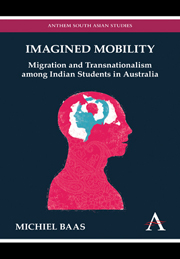Book contents
- Frontmatter
- Contents
- List of Illustrations
- List of Abbreviations and Acronyms
- Acknowledgements
- Chapter 1 Departure – Migration, Transnationalism and What Lies In-Between
- Chapter 2 First Semester – Of Leaving and Arriving: From and to a Culture of Migration
- Chapter 3 Second Semester – Some History Lessons as well as Learning the Hard Way
- Chapter 4 Summer School – A History of Students Going Overseas
- Chapter 5 Third Semester – Learning How to Work In-Between: Legal and Illegal Realms
- Chapter 6 Fourth Semester – Graduating as a Migrant
- Chapter 7 Arrival – Imagined Mobility
- Chapter 8 A New Departure – Curry Bashing and Alien Space Invaders
- Appendix Data, Dilemmas and Doing Fieldwork the Ethical Way
- Notes
- References
- Index
Chapter 3 - Second Semester – Some History Lessons as well as Learning the Hard Way
Published online by Cambridge University Press: 05 March 2012
- Frontmatter
- Contents
- List of Illustrations
- List of Abbreviations and Acronyms
- Acknowledgements
- Chapter 1 Departure – Migration, Transnationalism and What Lies In-Between
- Chapter 2 First Semester – Of Leaving and Arriving: From and to a Culture of Migration
- Chapter 3 Second Semester – Some History Lessons as well as Learning the Hard Way
- Chapter 4 Summer School – A History of Students Going Overseas
- Chapter 5 Third Semester – Learning How to Work In-Between: Legal and Illegal Realms
- Chapter 6 Fourth Semester – Graduating as a Migrant
- Chapter 7 Arrival – Imagined Mobility
- Chapter 8 A New Departure – Curry Bashing and Alien Space Invaders
- Appendix Data, Dilemmas and Doing Fieldwork the Ethical Way
- Notes
- References
- Index
Summary
Lessons to be Learned and Understood
In the previous chapter, it was described how for many Indian students newly arrived in Australia, the first opportunity to meet the local Indian community came at the Holi celebrations held at the temple at Carrum Downs. Having arrived in Australia, matters such as finding a place to live, looking for jobs, etc., have to be taken care of. Those students with contacts (family, friends or acquaintances) in Australia often lost touch with them once they had found a place to live. Reasons varied from being too busy with ‘other’ things to simply not being interested in maintaining the contact. Aside from these reasons, though, it also appeared as if this was never supposed to be the case anyway. These contacts were never meant to remain long-lasting ones, something that was inherently understood from the start. This is rather surprising. The way international discourses and narratives on issues such as assimilation and integration take shape, one could argue that, in general, migrants are understood not only to have strong ties with people still living in the place of origin but to further strengthen these ties once they have migrated. Newcomers are imagined to quickly integrate in already locally established groups of migrants with whom they share a similar national/cultural background. Why then does this not appear to happen in the Australian case?
- Type
- Chapter
- Information
- Imagined MobilityMigration and Transnationalism among Indian Students in Australia, pp. 51 - 78Publisher: Anthem PressPrint publication year: 2010



